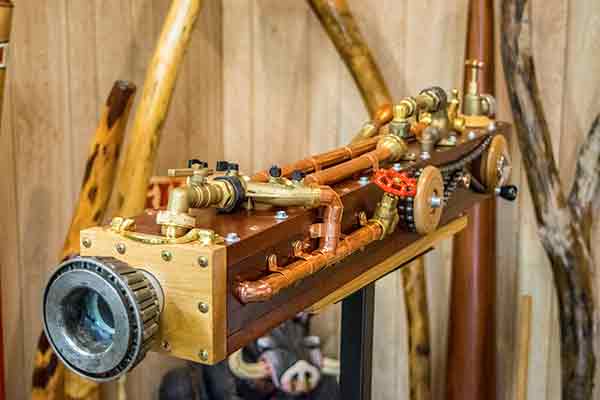

and
Oddgeridoos
Individually hand crafted to be played.
Agave and Split Didgeridoos
|
|
|
|
Rob Day with his favourite 100 year old didgeridoo, his favourite Agave didgeridoo and his hand carved Oddgeridoo. All of which Rob considers exhibition pieces. |
A photo showing the Agave Americana or Century plant. Also known as American Aloe. |
|
Creating something different
and possibly unique Rob has always had a fascination of this wonderful, mystical Aboriginal instrument, the didgeridoo. Musicologists classify the didgeridoo as an Aerophone. Possibly the world's oldest known wind instrument. After buying one from Kristian Benton, a Ngemba man and master didge maker and player, Rob decided he had to learn to play it. Who better to teach him than Kristian Benton? It didn’t stop there! After studying Aboriginal and European methods of construction, Rob, being a professional woodworker and craftsmen decided to try his hand at creating his own didgeridoos.
Out of respect for the Aboriginal culture and the true didgeridoo, Rob calls his non-traditional didgeridoos, Oddgeri(s), or Oddgeridoos, so the Didgeridoo connection is obvious. Rob is not an Aborigine. Initially, Rob was only creating didges for his own use, but after a discussion with a local Aboriginal elder, who wanted Rob to be on the lookout for natural didgeridoos, Rob decided he could create and supply the locals with playable and quality didgeridoos. Occasionally, Rob finds a natural didgeridoo that has been eaten out by ants. Read the Newcastle Herald review Rob’s goal was to create a playable and quality musical instrument for the lovers of the didgeridoo. Rob’s didges look deadly
and sound deadly too!
Oddgeridoos
Hand made to be played Decorated and Non Decorated. Beginners to Professionals. Didgeridoos and Oddgeridoos Rob creates his didgeridoos using traditional and non traditional methods. One of Rob's construction methods utilises drying and hollowing out the agave spikes found in the local area. This method ensures Rob can make didgeridoos, as finding a natural hollow log, eaten out by ants, and also plays a decent musical key is becoming progressively harder to find. Rob uses an electronic tuner to determine the key a didgeridoo plays.
Our range starts at $65 for a beginners' didgeridoo, up to the professional quality Didgeridoos and Oddgeridoos. |
|||||||||||
|
A selection of Agave and split didges, shown
here, are examples and no longer our current stock. More to view
for This is Not Our Current stock |
|
|
$75 |
|
|
|
|
|
Agave 1.2 metres Natural mouthpiece key of E with A overtone. |
Closer view |
|
|
|
|
Agave 1.25 metres Natural mouthpiece key of E with A overtone. |
|
|
|
|
|
Agave 1.45 metres Wax mouthpiece Key of B with E overtone. |
|
|
|
|
|
Didgeridoos The Australian government and all its agencies have formally accept didjeridu as
the correct spelling. It is
also fairly certain that the earliest usage of the expression applied to
instruments encountered in Western Arnhem Land or in the region to its immediate
south, where repeating rhythms or sound patternings such as "didjeridu-dideru",
"didjemro" and "didjeramo-rebo" are found. However, today, the word didjeridu is
used much more generally to include instruments originating from all parts of
Aboriginal Australia as well as a broad spectrum of instruments produced by
indigenous and non-indigenous makers utilising an array of modern materials and
methods. Most didgeridoos are around 1.2 m (4 ft) long. The length is directly related to the 1/2 sound wavelength of the keynote. Generally, the longer the instrument, the lower the pitch or key of the instrument. The didgeridoo is played with continuously vibrating lips to produce the drone
while using a special breathing technique called circular breathing. This requires breathing
in through the nose whilst simultaneously expelling air out of the mouth using
the tongue and cheeks. By use of this technique, a skilled player can replenish
the air in their lungs, and with practice can sustain a note for as long as
desired. Recordings exist of modern didgeridoo players playing continuously for
more than 40 minutes Traditionally and originally, the didgeridoo was primarily played as an accompaniment to ceremonial dancing and singing, however, it was also common for didgeridoos to be played for solo or recreational purposes outside of ceremonial gatherings. For surviving Aboriginal groups of northern Australia, the didgeridoo is still an integral part of ceremonial life, as it accompanies singers and dancers in surviving cultural ceremonies. Today, the majority of didgeridoo playing is for recreational purposes in both Indigenous Australian communities and elsewhere around the world. Didgeridoo Performance and Demonstration - Didgeridoo.pdf - download for info |
|
Click here for a YouTube video that depicts our products and Didgeridoos |
Come and browse our range of Didgeridoos
and Oddgeridoos!
|
Horn type Agave Didgeridoos |
|
Oddgeridoos |
|
|
||
|
The agave spikes can produce some wonderful large horn type didgeridoos, like shown in the above photograph on the left. |
||
"Steampunk" Didgeridoo!


DVD
Click image for more info
Copyright(c) 2008 New England Woodturning All rights reserved.
newts@newagemultimedia.com